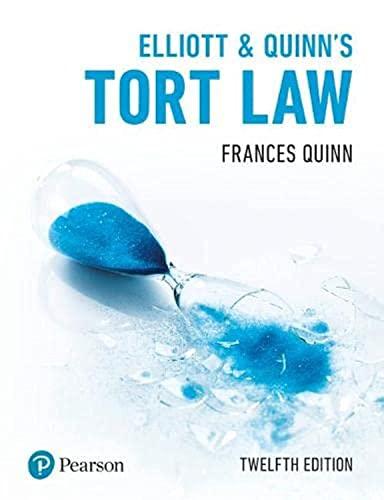Question
The Cos Act 1983 defined the terms 'holding company' and 'subsidiary company' in s.156. Section 156(1) provided: ' (1) For the purposes of this Act,
The Cos Act 1983 defined the terms 'holding company' and 'subsidiary company' in s.156.
Section 156(1) provided:
'(1) For the purposes of this Act, a company shall, subject to the provisions of subsection (3), be deemed to be a subsidiary of another if, but only if-
(a)that other either-
(i) is a member of it and controls the composition of its board of directors; or
(ii) holds more than half in nominal value of its equity share capital; or
(b)the first-mentioned company is a subsidiary of any company which is that other's subsidiary.'
Further subsections then elaborated on the basic tests in subs(1).
Subsection (3) provided:
(3) In determining whether 1 company is a subsidiary of another-
(a)any shares held or power exercisable by that other in a fiduciary capacity shall be treated as not held or exercisable by it;
(b)subject to paragraphs(c)and(d), any shares held or power exercisable-
(i) by any person as a nominee for that other (except where that other is concerned only in a fiduciary capacity); or
(ii) by, or by a nominee for, a subsidiary of that other, not being a subsidiary which is concerned only in a fiduciary capacity,shall be treated as held or exercisable by that other;
(c) ...
(d)any shares held or power exercisable by, or by a nominee for, that other or its subsidiary...shall be treated as not held or exercisable by that other, if the ordinary business of that other or its subsidiary, as the case may be, includes the lending of money and the shares are held or power is exercisable as aforesaid by way of security only for the purposes of a transaction entered into in the ordinary course of that, business.'
None of this is easy reading. I think the new Act is much easier to read. But query, does the new Act fail to address an important issue?
Focus on s.156(3)(b).
Paragraph (b) utilises a highly efficient grammatical structure.
Let me restate the provision in more accessible language (albeit less efficient).
Here it is:
'Subject to paragraphs (c) and (d), any shares held ... -
(i) by any person as a nominee for that other (except where that other is concerned only in a fiduciary capacity) shall be treated as held or exercisable by that other;andsubject to paragraphs (c) and (d), any shares held ...
(ii) by ... a subsidiary of that other, not being a subsidiary which is concerned only in a fiduciary capacity
... or by a nominee for a subsidiary of that other, not being a subsidiary which is concerned only in a fiduciary capacityshall be treated as held or exercisable by that other.''
We can simplify further by omitting the qualifications (the 'subject' and the 'except' and the 'not being') and again expanding the grammar.
Here it is:
'...any shares held ... (i) by any person as a nominee for that other ... shall be treated as held or exercisable by that other; and
... any shares held ... (ii) by ... a subsidiary of that other ... shall be treated as held or exercisable by that other and
... any shares held ... (ii) ... by a nominee for a subsidiary of that other ... shall be treated as held or exercisable by that other.'
Looking at this last restatement of subs.3 consider this.
Does subs(3)(b) provide rules that we might use in applying the majority ownership test?
Does the Cos Act 2015 provide any equivalent rules?
Here are the questions you are required to post on.
Suppose Aco owns 55% of the ordinary shares of Bco and Co.
Bco and Cco each own 30% of the shares of Dco.
(i)Under the 1983 Cos Act, is Dco a subsidiary of Aco?
(ii)Under the 2015 Cos Act, is Dco a subsidiary of Aco?
(In answering these two questions presume we have no information concerning 'control' of the board or 'control' of votes in a general meeting. I.e. we are only considering the majority ownership test.)
Step by Step Solution
There are 3 Steps involved in it
Step: 1

Get Instant Access to Expert-Tailored Solutions
See step-by-step solutions with expert insights and AI powered tools for academic success
Step: 2

Step: 3

Ace Your Homework with AI
Get the answers you need in no time with our AI-driven, step-by-step assistance
Get Started


